Article from the
Weekend Gardener Online Magazine
by Hilary Rinaldi, member of the National Garden Writers Association

Grow
the Juiciest Melons Ever
Enjoy
sweet, flavorful watermelons, muskmelons and honeydew this summer!
There
is nothing more indicative that summer is truly here than sitting down
to juicy, home-grown melons.
Many
people have their favorite kind of melon, and yes, there are a lot of
melons that can be grown, but most people tend to grow watermelon (Citrullus lanatus),
as well as muskmelon (also called cantaloupe or rockmelons), and
honeydew which are variations of the same species Cucumis melo.
Watermelon,
honeydew, and cantaloupe are considered quite easy to grow, and all are
grown in much the same way, so whatever type of melon you decide to
grow, if you follow the steps below, you will have fresh melon for
breakfast or in a good fruit salad in just a few weeks.
|
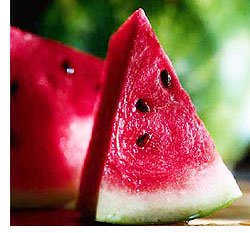 |
Step
by Step
Choosing
Plants
As
mentioned above, the most popular melons grown are watermelon,
honeydew, and muskmelon (also called cantaloupe or rockmelon), but when
deciding which variety to buy, such as seedless, here are a few things
to keep in mind:
Disease
Resistant:
When
choosing muskmelon, make sure you choose a variety that is resistant to
powdery mildew. Powdery mildew usually develops as the melons are
ripening and the energy the plant loses can rob the melon of their
flavor.
When choosing watermelon plants, look for varieties that are resistant
to fusarium wilt and bacterial wilt.
Short-Vined
Vs. Long-Vined:
Also,
choose long-vined cultivars rather than the short-vined or bush type.
This is because long-vined will have fruit with superior flavor and
texture because they have more leaves and can put more energy into
fruit production.
If you are short on space and need to grow a
short-vined or bush type variety, then thin the fruit to two melons per
plant to keep the fruit-to-leaf ration high.
Fruit
Type:
Typically,
muskmelon have soft-textured flesh, but some cultivars are described as
very firm-fleshed or crisp, just keep in mind that crisp varieties will
have flesh that is crunchy like a cucumber.
So be picky about
what kind of melon you are going to grow, and pay attention to the
details given to you on the back of the seed packet so you're not
surprised when you sit down to eat your melons.
Culture
Melons
like full sun, hot days, warm nights, and lots of room to grow. They
also need moderately rich and well-drained soil that has a pH of 6.0 to
6.8.
Melons really dislike extremely acidic soil, so choose a spot that has
naturally alkaline soil, or has recently been limed.
Planting
and Spacing
Melons need very warm soil and will not
grow well in soil that is cooler
than
60° F (16° C). They don't tolerate any frost, so make sure to
sow seeds outdoors two weeks after the last expected frost.
You
can use rows or hills to plant your melons, but one method is not any
better than another, it just depends upon what suits you best.
Some gardeners like to put several plants together in a clump or
"hill," while other people like to plant in conventional rows.
Weeding
is easier with the hill method, but if you water with soaker hoses or
drip irrigation lines, planting in rows will be the best way to go.
If using hills: plant two to four plants per hill with the hills spaced
2 to 3 feet (.5 to 1 m) apart.
If using rows: plant 8 to 12 inches (20 to 30 cm) apart in rows and
make sure the rows are 6 to 10 feet (2 to 3 m) apart.
How
Many To Plant
Short-vined or bushy muskmelon and
watermelon will produce two or
three fruits per plant. Long-vined types will produce up to five fruits
per plant.
Ripening tends to be uniform so you can plan on all of the fruits being
mature in a three week period.
Crop
Rotation
If
you follow good crop rotation, plant melons in an area that previously
had legumes, tomatoes, peppers, or leafy greens, but not after other
cucurbits or corn.
Watering
and Care
Melons
need plenty of water while they are young, and regular deep watering is
especially crucial during the first 3 to 4 weeks that the vines are
growing in your garden.
That said, you can improve the flavor of the fruit if you don't water
as
often
as the fruit ripens. A good technique is to cut back on the water once
the plants have begun to set fruit because overwatering dilutes the
melon's sugars and makes the flavor weaker and less sweet.
This
is a fine line, because you never want the melons to dry out
completely, or get too stressed for water, because when you do water
again, or it rains, the ripening melons can split.
So simply reduce the water but not to the point where you are stressing
the plant.
To give a steady supply of moisture, drip irrigation or soaker hoses are
the
best way, because you are watering the roots directly rather than
soaking the leaves. By keeping the leaves dry, you can help prevent
common foliar diseases such as powdery mildew which can affect the
flavor of the melons.
Important
Note:
Try
not to disturb or move the vines as the plants grow, even to weed. If
you disturb the vines, you can interrupt the flow of nutrients to the
melons which increases the risk that the melons will ripen on one side,
but stay green on the other side.
The best thing to do is to
weed the melon patch really well just as the vines begin to grow and
then heavily mulch to keep weeds under control.
Fertilize
Melons
are heavy feeders and from the time they start growing until the first
flower appears, melons need a steady supply of nutrients. A good
formula is to mix a solution of 1 to 2 tablespoons (15 to 30 ml) of
fish emulsion in 1 gallon (3.8 l) of water and apply it weekly when the
plants are young.
An application of a kelp-based foliar spray when the plants are in full
flower will complete fertilization.
Days to
Maturity
You can plan 75 to 90 days from seed,
depending on the cultivar.
Harvesting
Melons can be hard to tell if they are
ripe, but here are some common techniques.
Muskmelons:
develop a thick netting over the rind, and the rind beneath becomes a
lighter shade of green or even yellow.
Watermelons:
when ripe, the curled tendril at the stem end dries to brown and the
underside of the melon turns yellow or cream-colored. The melon will
also give a flat, dead sound when thumped. Rinds of unripe watermelons
have a nice shiny gloss; ripe melons lose that shine, so the rinds are
drab.
Other
melons: Slip from the vine when ripe.
All
melons will ripen a bit more for a couple of days after harvest, so
store them at room temperature until they are totally ripe, then put
them in the refrigerator or cool location for several weeks.
Some
Common Pests
Squash bugs, cucumber beetles (which
also carry bacterial wilt), squash vine borers, and aphids (carriers of
mosaic viruses).
Cucumber
beetles:
typically prefer cucumbers and muskmelons, but they will occasionally
eat watermelons, too. Insecticidal soap is an organic, effective
treatment for most cucumber beetle infestations.
If you've had
major cucumber beetle problems in the past, use row covers to keep them
from getting to your vines, just remember to remove the covers when the
vines begin to flower so that bees can pollinate them. If you don't,
the plant won't set fruit.
Squash
vine borer larvae:
can tunnel into watermelon vines, eating the inner tissue at the base
and filling the stem with slimy castings. The attacked vines will wilt
suddenly and rot and die. To help avoid these pests, row covers are the
best defense.
Some
Common Diseases
Powdery mildew, mosaic viruses, angular
leaf spot and other fungal and bacterial diseases.
Conclusion
The
great news is that all melons are pretty easy to grow, so no matter if
you are new to gardening or an old hand, make sure you plant some.
Now, if growing melons turns out to be too easy for you, try doing it
the Japanese way! Check this out!
In
Tokyo store space is very limited, but there are a lot of customers to
sell to. The stores however, can't have round watermelons because they
take up too much room, and they have too much empty space around them.
No
problem. They came up with the idea to grow melons inside a box, and
when they're fully grown, they simply take them out of the box and can
be stacked. It cuts down on transportation costs, and the grocery
stores can handle them better.
So have fun and have a great summer!
|
Watermelon:

Muskmelon (also called rockmelon or cantaloupe)
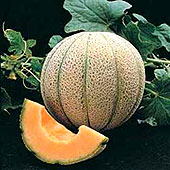
Honeydew:
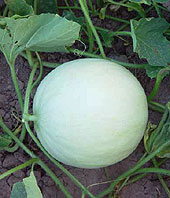
Melons in rows:
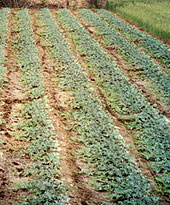
Melons in hills:
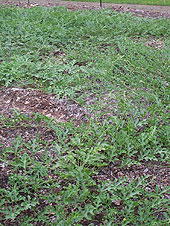
Drip line:
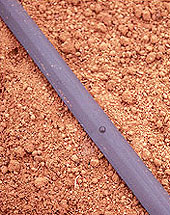
Don't disturb the vines:
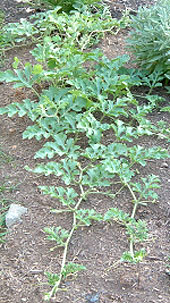
Muskmelon slip from the vine:

Watermelon have a brown tendril and creamy of yellow underside:
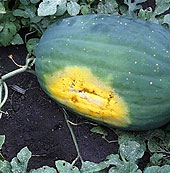
Close up of watermelon brown tendril:


 |
Hilary
Rinaldi is a member of the National Garden Writers Association, a
nationally published writer, and a certified organic grower. She
regularly speaks and writes about all gardening related topics, with an
emphasis on making gardening a successful and enjoyable process for
anyone who wants to learn. Weekend Gardener Monthly Web Magazine
concentrates of giving detailed gardening tips and gardening advice to
all levels of gardeners.
Back to
Watermelon Page
|
Copyright WM Media. All rights reserved.
This work is licensed under a Creative Commons Attribution-NoDerivs 2.5
License.
|













